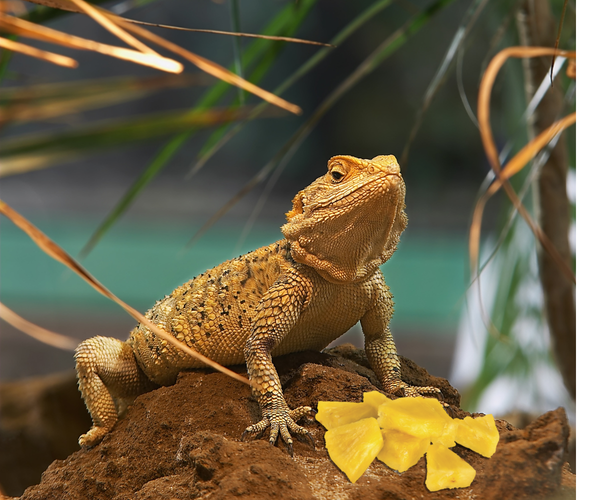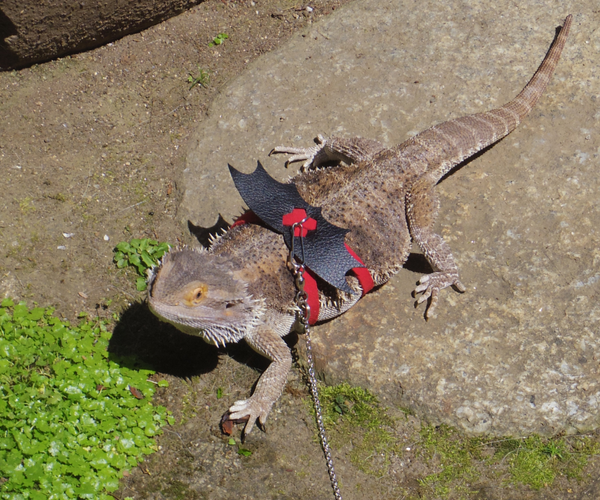Can Bearded Dragons Swim? The Aquatic Abilities of Your Pet Dragon
This article dives into the aquatic abilities of bearded dragons, providing insights and guidelines for pet owners who are curious about introducing their scaly friends to water.

Key Takeaways:
- Bearded dragons have the physical capability to swim, but it's not a natural or necessary activity for them.
- Supervision and safety measures are crucial when allowing a bearded dragon to swim.
- Understanding the natural habitat and behavior of bearded dragons can guide responsible swimming sessions.
Bearded dragons, the charismatic reptiles from Australia, have become beloved pets in many households. Their unique behaviors and manageable size make them ideal for reptile enthusiasts. A question that often surfaces among bearded dragon owners is whether these creatures can swim. This article dives into the aquatic abilities of bearded dragons, providing insights and guidelines for pet owners who are curious about introducing their scaly friends to water.
The Natural Habitat of Bearded Dragons
Bearded dragons hail from the arid, desert regions of Australia, where water bodies are not a common feature in their landscape. Their natural habitat consists of dry, rocky areas with sparse vegetation. This environment has shaped their behavior and physical adaptations, making them well-suited for terrestrial life. While they do encounter occasional rain and may drink from puddles, swimming is not an activity that is typically necessary for their survival in the wild.
Despite their desert origins, bearded dragons do encounter water and can exhibit swimming behavior. In captivity, some owners have observed their bearded dragons paddling in water with varying degrees of enthusiasm. It's important to note that while they can swim, it is not an activity that they would frequently engage in naturally.
Understanding Bearded Dragon Physiology
The anatomy of a bearded dragon is designed for a life spent mostly on land. They have sturdy limbs for crawling and climbing, and their lungs are well-adapted for breathing air in dry conditions. However, when placed in water, bearded dragons can float and use their limbs to paddle. Their semi-aquatic capabilities are not as developed as those of other reptiles, such as turtles or water dragons, but they can manage to keep afloat and move in water to some extent.
It's crucial to understand that bearded dragons are not built for prolonged swimming. Their body structure and muscle composition are not designed for efficient aquatic locomotion. Extended periods in water can lead to fatigue and stress, which can be detrimental to their health. Therefore, any swimming activity should be closely monitored and kept brief to ensure the safety and well-being of the pet.
Safety Precautions for Swimming Bearded Dragons
When introducing a bearded dragon to water, it's essential to prioritize their safety. The water should be shallow enough for them to touch the bottom with their feet, allowing them to feel secure. The temperature of the water must also be considered; it should be lukewarm to prevent any shock to their system, which is sensitive to temperature changes.
Always supervise your bearded dragon during swim time. They should never be left unattended in water, as they can easily become exhausted or even drown if they cannot reach a safe area to rest. Additionally, the swimming area should be free of any hazards or substances that could harm the dragon, such as chlorine or other chemicals commonly found in pools.
The Benefits of Controlled Swimming Sessions
Swimming can offer several benefits for bearded dragons when done correctly and safely. It can serve as a form of physical exercise, helping to keep them active and potentially aiding in weight management. Additionally, swimming can help with shedding, as the water can soften and loosen dead skin, making it easier for the bearded dragon to shed.
However, these benefits can only be realized if the swimming sessions are kept short, safe, and stress-free for the dragon. It's also important to note that swimming should not replace their regular forms of exercise and activity, which are more in line with their natural behaviors and needs.
Setting Up a Swim-Friendly Environment
Creating a swim-friendly environment for your bearded dragon involves choosing the right container or area for them to swim in. A bathtub, sink, or a specially designed reptile pool can be suitable options, as long as they are clean and the water is at an appropriate depth and temperature.
The swimming area should be easy for the bearded dragon to enter and exit. You can use ramps or smooth rocks to provide access points. The environment should also be calm and quiet, without loud noises or disturbances that could stress the dragon. After swimming, it's important to thoroughly dry your bearded dragon and return them to their warm, dry habitat to prevent any respiratory issues.
Monitoring Your Bearded Dragon's Response to Water
Each bearded dragon is unique, and their response to water can vary. Some may enjoy the sensation and paddle around curiously, while others may become anxious or try to escape. It's important to observe your bearded dragon's behavior closely and remove them from the water if they show any signs of distress.
Positive signs to look for include relaxed body language, active paddling, and an overall calm demeanor. If your bearded dragon seems to enjoy the water, you can gradually increase the duration of the swimming sessions, always keeping safety in mind.
The Debate: To Swim or Not to Swim?
The question of whether bearded dragons should swim is a topic of debate among reptile enthusiasts and experts. While they have the capability to swim, it is not a natural or essential part of their lifestyle. Some argue that swimming can be a beneficial and enriching activity, while others believe it should be avoided due to the potential risks and stress it can cause.
Ultimately, the decision to allow your bearded dragon to swim should be based on a thorough understanding of their needs, behavior, and individual preferences. It should also be informed by a commitment to providing a safe and controlled environment for any aquatic adventures.
Health Considerations and Potential Risks
While swimming can have benefits, there are also health considerations and potential risks to be aware of. Prolonged exposure to water can lead to skin infections or respiratory issues if the bearded dragon is not properly dried off or if the water is not clean. Additionally, the risk of drowning is a serious concern, especially if the dragon becomes tired or the water is too deep.
It's important to consult with a veterinarian experienced with reptiles before introducing your bearded dragon to swimming. They can provide guidance on how to do so safely and what signs to watch for that may indicate a health issue.
After the Swim: Care and Maintenance
After a swimming session, it's important to take proper care of your bearded dragon to ensure their comfort and health. Gently pat them dry with a soft towel, making sure to remove any excess moisture, especially from their eyes and nostrils. Return them to their habitat, which should be at the appropriate temperature to prevent any thermal shock.
Monitor your bearded dragon for any changes in behavior or health following the swim. If you notice anything unusual, such as lethargy, loss of appetite, or respiratory issues, contact your veterinarian for advice.
Summary
Bearded dragons can swim, but it's not an activity that is natural or necessary for them. If you choose to introduce your pet to water, it should be done with caution, supervision, and adherence to safety guidelines. Swimming can provide physical exercise and aid in shedding, but it should never compromise the health or well-being of the dragon. Always prioritize the unique needs and preferences of your bearded dragon when considering swimming as an enrichment activity.
FAQ Section
Q: How often can I let my bearded dragon swim? A: Swimming should be an occasional activity, not a regular part of your bearded dragon's routine. Limit swim sessions to once a week or less, and always ensure they are brief and supervised.
Q: Can bearded dragons drown? A: Yes, bearded dragons can drown if they are left unsupervised in water that is too deep or if they become exhausted. Always keep the water shallow and supervise your pet closely.
Q: Do bearded dragons enjoy swimming? A: This can vary from one bearded dragon to another. Some may enjoy the sensation of water, while others may not. It's important to monitor your pet's behavior and only continue swimming sessions if they seem to be enjoying themselves without any signs of stress.




